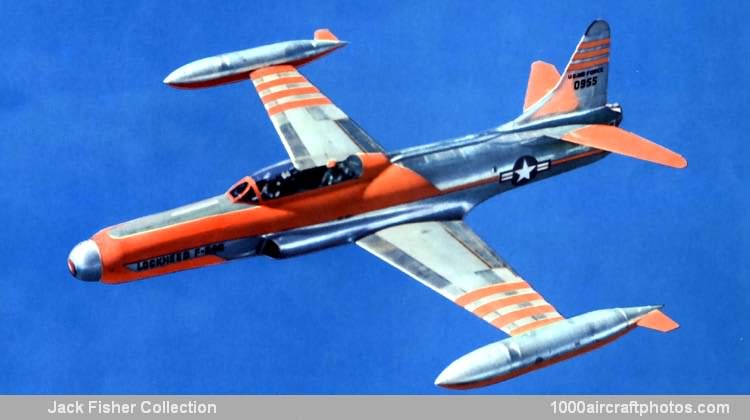05/31/2010. Remarks by Johan Visschedijk: "In July 1948, four months before receiving the contract for the first batch of F-94As, Lockheed proposed to the USAF a more advanced development of the TP-80C. Bearing the Temporary Design Designation L-188 and unofficially dubbed 'F-94B', this design featured an all-new wing with reduced thickness, revised speed brakes, increased fuel capacity, all-rocket armament, and a Hughes E-5 fire-control system with APG-40 radar. Power was to be provided by a Pratt & Whitney J48 afterburning turbojet, a license-built version of the Rolls-Royce Tay.
Even though the Air Force initially preferred to endorse the interim F-94A and to back the more advanced North American F-86D and Northrop F-89, Lockheed decided in 1949 to proceed with the private venture construction of a demonstrator combining the L-188's new wing with an F-94A fuselage from which the armament and radar systems were omitted. As the J48 was not yet ready, the demonstrator was completed with a non-afterburning Rolls-Royce Tay and, bearing the civil registration N94C, was first flown by Tony LeVier on January 19, 1950.
One month later Lockheed's perseverance was rewarded when the Air Force finally purchased the unarmed L-188 demonstrator as the first YF-97 prototype, the serial 50-955 then replacing the aircraft's original civil registration, and ordered a fully militarized prototype (s/n 50-877). When initial trials with the L-188 demonstrator revealed several problems, this aircraft, as well as the second YF-97 prototype, was progressively modified.
Changes included the removal of the wing root extension fillet to improve stall characteristics on the approach, the replacement of the original F-94 stabilizer with power-boosted swept surfaces to eliminate high-frequency vibration at high Mach numbers, the addition of dampers to correct aileron buzzing and of spoilers to increase roll control, and the enlargement of the vertical fin to increase directional stability at high speeds. The first aircraft was also re-engined with a J48-P-3 engine with a dry rating of 6,000 lb (2,722 kg) and afterburning rating of 8,000 lb (3,629 kg).
Redesignated YF-94Cs on September 12, 1950, these prototypes were used to test the improved fire-control system and all-rocket armament consisting of twenty-four 2.75 in (70 mm) FFAR (Folding-Fin Aerial Rockets), in four groups surrounding the APG-40 radome and covered by snap-action doors. They were also used to test the much revised fuel system with 566 gal (2,141 l) in wing and fuselage tanks, 500 gal (1,891 l) in tip tanks and 460 gal (1,741 l) in slipper tanks for a total capacity of 1,526 gal (5,773 l) as opposed to 783 gal (2,964 l) for the F-94B and F-94A with Fletcher tip tanks.
Flight trials progressed slowly due to drag chute difficulties, automatic pilot unreliability, aileron flutter and afterburner problems. These troubles were not resolved until October 1951, after delivery of the first production F-94C."
